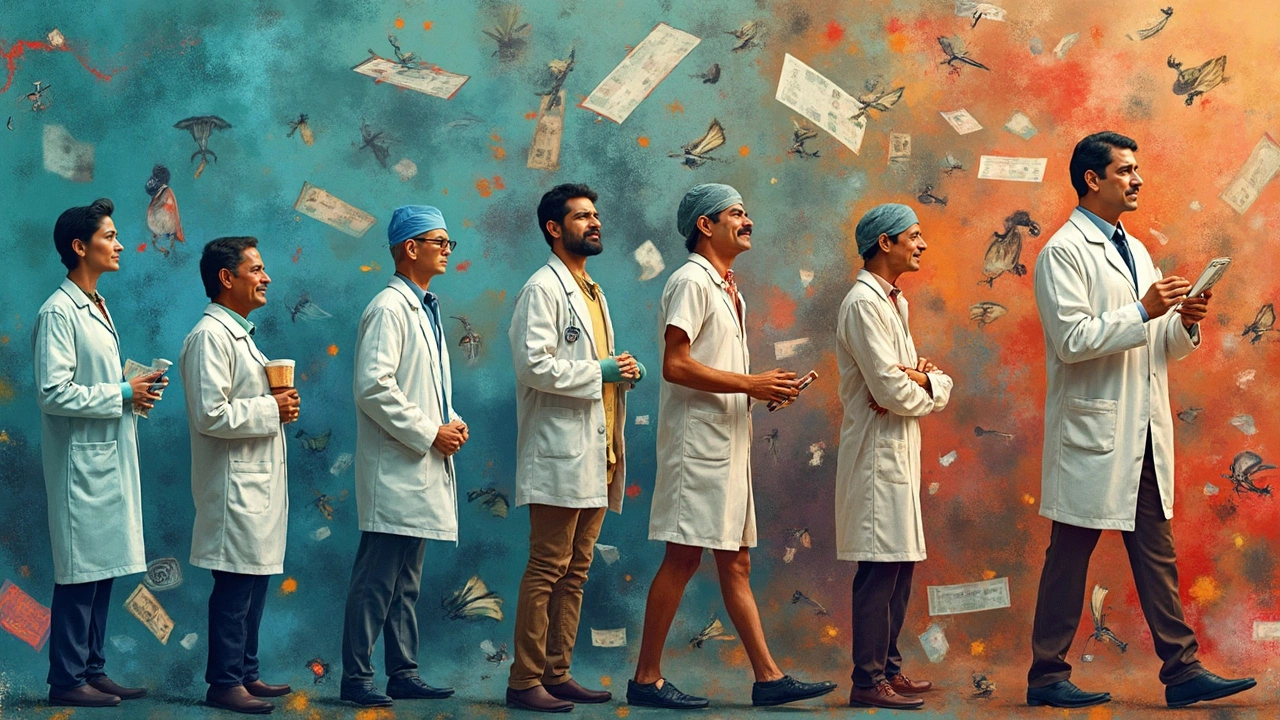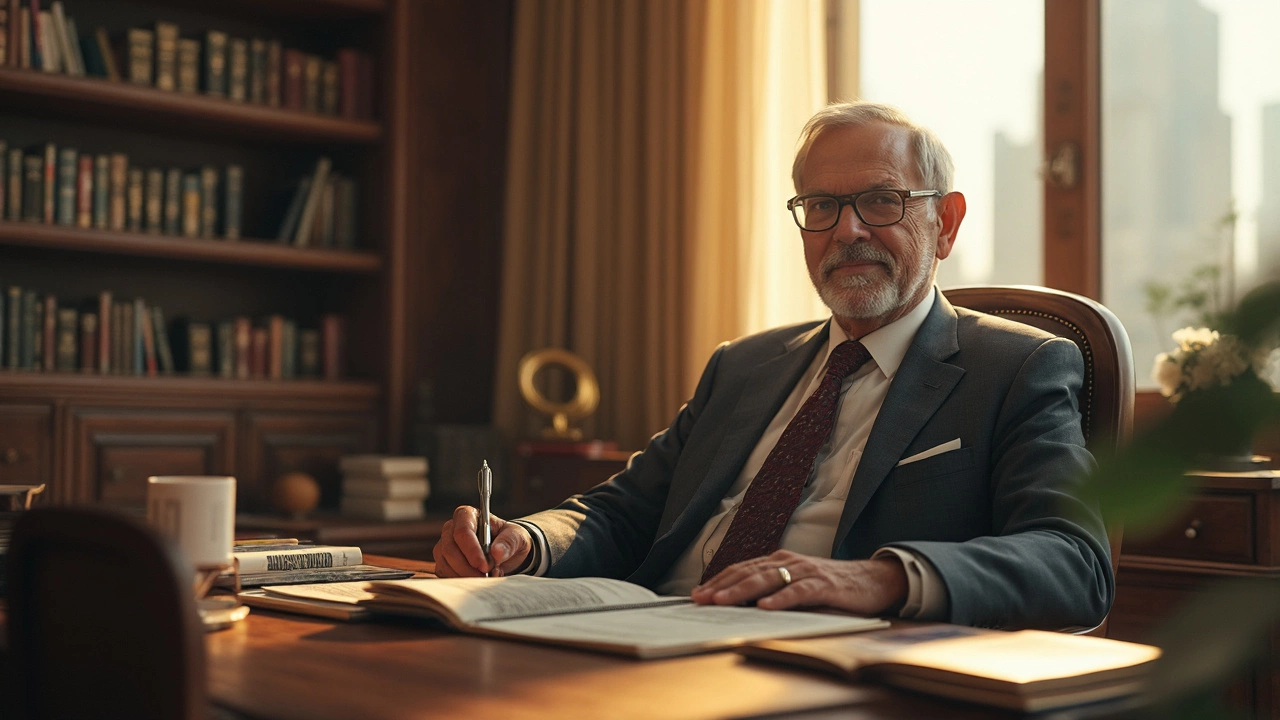Ever wondered if becoming a doctor can actually make you super rich? Spoiler: it can, but probably not the way you think. Let’s talk straight—being a top doctor isn't only about treating patients or acing your boards. The richest doctor in the world, Dr. Patrick Soon-Shiong, didn’t get his billions just from seeing patients day in and day out.
Now, before you start imagining luxury cars and private jets, there’s more to the story. Dr. Soon-Shiong’s path went way beyond stethoscopes and prescriptions. He turned medical knowledge into business ideas: cancer drugs, biotech companies, and a bunch of patents. The lesson here? Medicine opens more doors than just those at the hospital—and knowing this early can change how you look at NEET prep or your future as a doctor.
So, if you’re aiming to crack NEET and head off to med school, knowing stories like his can actually get you thinking bigger. Medicine is about helping people, but it’s also about solving problems and—sometimes—making a serious impact on the world, financially and otherwise. Stick with me as we dig deeper into what NEET aspirants like you can learn from the world’s wealthiest doctor and how you can make your own mark starting now.
- Meet the Richest Doctor: Fast Facts
- How Did He Make His Money?
- Lessons for Future Doctors
- What Does This Mean for NEET Aspirants?
- Tips for Building Success in Medicine
Meet the Richest Doctor: Fast Facts
Let’s get straight to the point—Dr. Patrick Soon-Shiong holds the title of the richest doctor in the world. If you think doctors only make money from seeing patients, his story will surprise you. Born in South Africa, and now based in the United States, Dr. Soon-Shiong is a surgeon, scientist, and billionaire entrepreneur. As of June 2025, his net worth is estimated to be around $8 billion, according to Forbes’ latest figures.
| Fact | Details |
|---|---|
| Full Name | Patrick Soon-Shiong |
| Born | July 29, 1952 (South Africa) |
| Net Worth | $8 billion (2025) |
| Main Source of Wealth | Biotech & Pharmaceuticals |
| Key Achievement | Developed Abraxane (cancer drug) |
| Other Roles | Owner of Los Angeles Times, Philanthropist |
His claim to fame isn’t just his white coat. Dr. Soon-Shiong invented and sold Abraxane, a cancer treatment drug that changed the game for oncologists. The drug became a blockbuster, and he sold his company for billions. He didn’t stop; he kept investing in healthcare tech, research, and even bought the Los Angeles Times. Not bad for a career that started in surgery.
"Dr. Soon-Shiong’s vision has redefined what it means to be a doctor in the 21st century by combining medicine, science, and business." – Forbes Health Innovation Report (2024)
Here’s a quick breakdown of what sets him apart from most MDs:
- Became a board-certified surgeon in the U.S.
- Built biotech companies like Abraxis and NantWorks
- Owns patents for dozens of medical innovations
- Major player in the fight against cancer and chronic diseases
So, cracking NEET could be your first step, but just look at how wide the world of medicine can get. The richest doctor on the planet proves that medical knowledge can build companies, help millions, and even reshape the healthcare industry.
How Did He Make His Money?
When you hear the name Dr. Patrick Soon-Shiong, think business and medicine smashed together. Here’s the deal—he started out as a regular doctor, doing surgery like a lot of others. But what set him apart was his move into medical innovation and business. He developed a cancer drug called Abraxane that changed the way doctors treat certain types of cancer. When big pharma companies saw its potential, they paid billions for it. That’s already a massive leap from the usual doctor salary.
But he didn’t stop there. Dr. Soon-Shiong kept launching biotech companies, investing in healthcare technology, and grabbing up patents for new treatments and devices. He even owns several hospitals and has ideas for how to change the entire US healthcare system. Take a look at how his biggest wealth moves broke down:
- Invented Abraxane, a top cancer drug, and later sold his company for around $4.5 billion.
- Founded NantWorks, a group of startups focused on healthcare tech and artificial intelligence.
- Bought a major stake in the Los Angeles Times, combining media and health influence.
- Owns multiple hospitals and invests in medical research, biotech, and even sports (he’s a part-owner of the Los Angeles Lakers).
Check out this snapshot of where his fortune came from:
| Source | Estimated Value / Sale |
|---|---|
| Abraxane Sale (Abraxis BioScience) | $4.5 billion |
| NantWorks (and NantHealth IPO) | $1+ billion |
| Investments & Patents | Hundreds of millions |
| Los Angeles Times Purchase | $500 million |
Here’s the real takeaway: becoming the richest doctor in the world wasn’t just about being great at medicine. It was about spotting big opportunities, thinking outside the clinic, and pushing the boundaries of what doctors can do. If you’re prepping for NEET, keep this in mind—what you learn in medical school can springboard you into all kinds of wild, world-changing careers.

Lessons for Future Doctors
Let’s get real—Dr. Patrick Soon-Shiong didn’t just stick to a regular clinic job. After becoming a surgeon, he moved into research and then built biotech businesses. So, what can you actually learn from his story if you’re planning your own med career?
- Think beyond the clinic. The highest-earning doctors are not necessarily the ones seeing the most patients. Dr. Soon-Shiong launched companies like Abraxis BioScience and invented the cancer drug Abraxane, which brought in huge profits.
- Combine medicine with other skills. He studied both medicine and business—earning degrees in surgery and then a master’s in medical science. Using that knowledge, he solved real-world problems and created new treatments.
- Be open to entrepreneurship. Don’t limit yourself to hospital work. Startups, pharma, tech—these options are growing for doctors. In fact, more than 20% of American doctors are now involved in some form of business or research work outside of day-to-day practice.
- Learn to network. Dr. Soon-Shiong built relationships with leading researchers, business people, and investors. Making friends in and outside of medicine can open unexpected doors.
Check out this table comparing what average doctors and Dr. Soon-Shiong focused on during their careers:
| Focus Area | Typical Doctor | Dr. Patrick Soon-Shiong |
|---|---|---|
| Direct Patient Care | 80-100% | Early career, later less |
| Research & Innovation | 10-20% | High—developed new cancer treatments |
| Business/Entrepreneurship | 5-10% | Major—built and sold biotech companies |
| Investments/Patents | Rare | Holds over 100 patents |
See the pattern? The world’s richest doctor kept learning and didn’t stay in one lane. If you’re prepping for NEET, don’t just memorize books—get curious about the big picture. Medicine can lead to way more opportunities than you might expect, and what you do after your degree matters even more than your board scores. If you want to make an impact (and maybe a fortune), start building new skills, not just your study notes.
What Does This Mean for NEET Aspirants?
Seeing a name like Dr. Patrick Soon-Shiong at the top of the list for richest doctors is a wake-up call for anyone gunning for NEET. He didn’t just stick to clinics or hospital rounds; he went after different opportunities in healthcare and business. That’s a game-changer mindset for NEET aspirants who usually get stuck on the idea that being a doctor means only treating patients.
If you’re grinding through NEET prep, don’t forget your bigger options. Medicine is evolving, and skills like research, innovation, and public speaking matter just as much as high marks. Dr. Soon-Shiong’s story proves it—he combined strong medical knowledge with smart business moves, creating treatments that changed lives and made him billions. Take in this advice that’s everywhere in med prep forums:
"It’s not just about getting into medical college. It’s about learning how to use your medical degree to make things better for everyone—and sometimes, that means thinking like an entrepreneur."
Want some numbers? Take a look at routes where doctors commonly earn and grow:
| Career Path | Potential Annual Income (₹) | Typical Pathway |
|---|---|---|
| Clinical Practice (India) | 10-30 lakh | MBBS/PG, hospital/private clinic |
| Medical Research | 15-50 lakh | MBBS/MD + research institute |
| Biotech/Pharma | 20 lakh–crores (top execs) | Medical degree + business |
| Healthcare Entrepreneurship | Unlimited (depends on venture) | Innovation + startup/business |
That table isn’t just wishful thinking. The real incomes can be much higher, especially if you go global or start something of your own. Almost every big breakthrough in medicine came from someone who pushed beyond the usual doctor’s path.
- Don’t stop at clearing NEET—see it as your first step.
- Stay curious: research, attend conferences, read about new tech in healthcare.
- Build skills outside textbooks—communication, leadership, and basic business know-how.
Long story short? Cracking NEET is important, but thinking ahead like Dr. Soon-Shiong puts you far ahead of the crowd. Chasing medical success doesn’t mean you choose between helping people and making money. It’s about keeping your eyes open for every way your expertise can leave a mark. The next chapter in medicine could have your name on it—if you’re willing to look beyond the obvious and be bold.

Tips for Building Success in Medicine
If you think success in medicine only comes from memorizing textbooks, it’s time to look at the bigger picture. Getting into a top medical school with a good NEET score is just your first step. Building a standout career, like some of the world’s top doctors, means picking up more skills and thinking differently.
- richest doctor stories prove that knowing medicine isn’t enough. Skills in business, communication, and even technology can set you apart. Dr. Patrick Soon-Shiong, for example, focused on cancer research, started drug companies, and filed over 230 patents. He used what he knew about medicine to solve big real-world problems—and that’s how he built his wealth.
- Keep your mind open. Along with studying for exams, pick up basic knowledge about things like healthcare startups, medical technology, or patent laws. Watching free online videos or reading articles about these topics while you prep for NEET can give you a huge edge long term.
- Network early—even as a student. Try to attend workshops, seminars, or even connect with seniors and doctors online. A lot of opportunities in medicine come from just knowing the right people at the right time.
- Don’t let failure stop you. Some of the most successful doctors messed up a few times before hitting it big. Dr. Soon-Shiong’s first business ideas didn’t work out, but he kept going. Treat every setback like a lesson, not the end of the road.
- If you have an idea—like a cheaper medical tool or an app that helps patients—don’t ignore it. Plenty of top doctors started small side projects as students. The earlier you try building real solutions, the faster you learn and stand out from the crowd.
So, if you want a future that goes beyond being just another doctor, focus not only on your studies but also on these extra skills. This combo is what can help you make an impact, and who knows, your name might be on that richest-doctor list one day.

